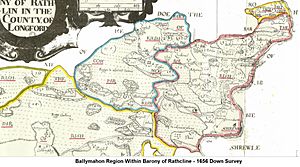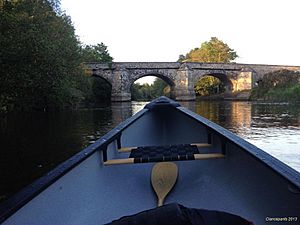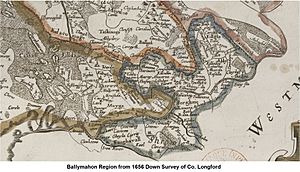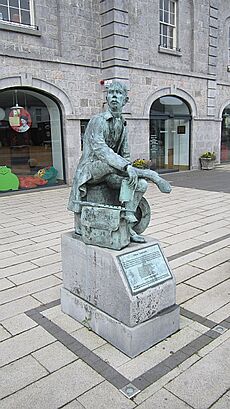Ballymahon facts for kids
Quick facts for kids
Ballymahon
Baile Uí Mhatháin
|
|
|---|---|
|
Town
|
|
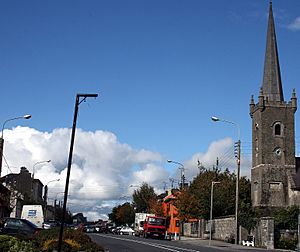
Ballymahon
|
|
| Country | Ireland |
| Province | Leinster |
| County | County Longford |
| Elevation | 82 m (269 ft) |
| Population
(2022)
|
1,714 |
| Time zone | UTC+0 (WET) |
| • Summer (DST) | UTC-1 (IST (WEST)) |
| Eircode routing key |
N39
|
| Telephone area code | +353(0)90 |
Ballymahon (which means "Mahon's town" in Irish) is a small town in the southern part of County Longford, Ireland. It is located on the River Inny, about 19 kilometers (12 miles) north-east of Athlone. The town is found where the N55 and R392 roads meet.
Contents
History of Ballymahon
Ballymahon gets its name from the Irish words "Baile Mathuna," meaning "Mahon's town." Some people believe this refers to Mahon, a powerful leader and older brother of Brian Boru. He might have fought a battle nearby in 960. Others think Mahon was a local leader of the O'Farrell family in the 1300s.
The first time Ballymahon was written about was in 1578. An old map from 1654, called the Down Survey, shows Ballymahon as a group of houses. These houses were at the southern end of the town, next to the River Inny.
In the mid-1800s, two important families, the Shuldham family and the King-Harman family, helped develop the town. Many buildings in Ballymahon are from this time. They have a style called late Georgian architecture. These are often two or three-story houses, painted in bright colors, and built in rows. The town is also known for its wide main street. From 1788 to 1853, the Roman Catholic bishops of Ardagh and Clonmacnoise lived here. The local church was used as a main cathedral until St. Mel's Cathedral was built in Longford.
Geography and Waterways
The River Inny flows through Ballymahon towards the west. This river is a branch of the larger River Shannon and flows into Lough Ree, which is about five kilometers (three miles) from the town. The part of the Inny River near Ballymahon is great for beginners learning to kayak or canoe.
The Royal Canal also goes through Ballymahon, heading west from Dublin to Clondra in County Longford. This canal has been fully repaired and is now open for boats to travel on. Brannigan Harbour, about one kilometer (half a mile) from Ballymahon, is a popular spot on the Royal Canal. It's a good place for boats to stop and is also used for water sports.
Important Buildings
Ballymahon has several interesting old buildings.
Churches
- St Matthew's Roman Catholic Church: Built in 1906, this church has a Gothic style. You can find it on the northwest side of Ballymahon.
- St Catherine's Church of Ireland Church: This church was built in 1800 and rebuilt in 1824. It has a tall, thin spire that stands out in the town.
Courthouse and Market House
The Ballymahon Courthouse and Market House was built in 1819. It is located in the center of town. Today, this historic building serves as a community library.
Old Police Barracks
Across from St Catherine's Church is the old police barracks. It was built on what locals believe was once a castle belonging to the O'Farrell family. You can still see parts of the old castle's earthworks nearby. This building became a police station for the Garda Síochána (Irish police) after Ireland became independent. It was used until 1996. During the Irish War of Independence in 1920, the barracks was involved in an event where local volunteers tried to get firearms.
Travel and Roads
Ballymahon is located on the N55 road, which is an important national road. This road connects Ballymahon to Athlone, about 22 kilometers (14 miles) to the south. It also leads towards Belfast and Northern Ireland. The county town of Longford is also 22 kilometers (14 miles) north of Ballymahon.
The R392 road links Ballymahon to Mullingar in the east and to Roscommon in the west. This route was once part of a very old ceremonial path. You can see parts of this ancient road at the nearby Corlea Trackway.
The Royal Canal connects Ballymahon to Dublin and to the River Shannon at Clondra.
For public transport, Bus Éireann route 466 connects Ballymahon with Athlone railway station. There is also a Local Link bus, route 24, that goes to Longford town and Longford railway station.
Education in Ballymahon
Ballymahon has a primary school called St. Matthew's National School. In 2019, it had over 360 students. There are also two secondary schools in the area: Mercy Secondary School and Ballymahon Vocational School. For college, the closest option is Athlone Institute of Technology in Athlone, which is about 22 kilometers (14 miles) away.
Culture and Sports
Ballymahon is home to the Bog Lane Theatre, a place for plays and performances. The town also hosts the Oliver Goldsmith Summer School. This is a festival about literature that happens every June. It includes poetry readings at Goldsmith's birthplace in Pallas. Ballymahon also holds the annual Still Voices International Film Festival.
For sports, the town has a Gaelic football club called Ballymahon GAA. There is also a soccer club, Ballymahon AFC.
Twin Towns
Ballymahon is twinned with two towns in France: Landévant and Landaul. These towns are in the Morbihan region of Brittany in north-west France. Being "twinned" means the towns have a special friendship. They often hold events and cultural exchanges each year.
Famous People from Ballymahon
Many notable people have connections to Ballymahon:
- Sir Thomas Molyneux (1661–1733) and William Molyneux (1656–1698): These brothers were important thinkers and writers. Their family owned large estates near Ballymahon.
- Thomas Marlay (c.1680–1756): He was a top judge in Ireland and was born near Ballymahon.
- Oliver Goldsmith (1728–1774): A famous author, he was born in a nearby area called Pallas and grew up in Lissoy. His mother lived in Ballymahon later in her life. There is a monument in Ballymahon that honors him.
- John Keegan Casey (1846–1870): Known as "the poet of the Fenians," he was born in County Westmeath. His family moved to Gurteen near Ballymahon, where his father was a schoolmaster. John later taught in the area and became involved in the Fenian movement.
- John Henry Patterson (1867–1947): A soldier and author, he was born near Ballymahon. His book The Man-Eaters of Tsavo tells about his adventures building a railway bridge in Kenya.
- Dr Kathleen Lynn: A doctor and activist for women's rights, she lived in Ballymahon for four years as a young girl (1882-1886). Her father was a church leader in the town.
- James Dooley (1877-1950): An Australian politician who became the Premier of New South Wales, he was born near Ballymahon.
- Maura Higgins (b.1990): A reality television personality who appeared on the show Love Island.
Images for kids
See also
 In Spanish: Ballymahon para niños
In Spanish: Ballymahon para niños



